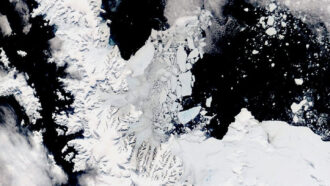Disappearing sea ice could disrupt Arctic’s food web
If ice-free is the new normal, then big changes are in store for life here
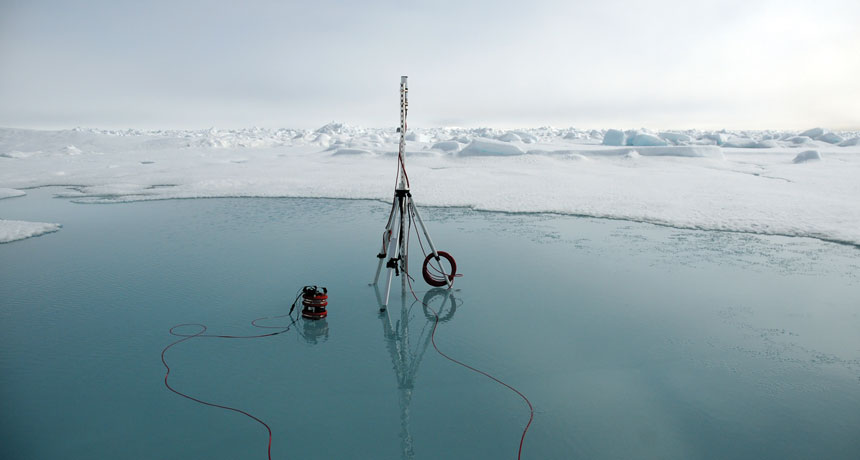
Cameras set up in the Arctic’s Chukchi and Bering seas (one shown) record the amount of light that reaches water through the ice. More light means more algal blooms.
K. Frey/Clark University
Peggy’s data were a bit of a shock.
Peggy is a floating buoy attached to sensors that monitor the temperature, saltiness and other properties of the Arctic’s Bering Sea. These sensors reach down more than 70 meters (about 230 feet) below the water and are anchored to the seafloor west of Alaska.
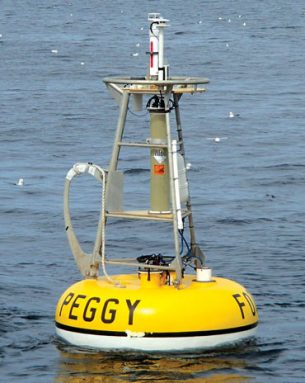
Here, the coming and going of floating sea ice follows a seasonal pattern. Peggy’s data normally show that pattern. But in the winter of 2017–2018, they didn’t. The sea ice never appeared!
At their closest point, Alaska and Russia are separated by the Bering Strait. This stretch of water is 82 kilometers (51 miles) wide. To the north lies the Chukchi Sea, which is on the edge of the Arctic Ocean. Below the strait is the Bering Sea, which extends south to Alaska’s Aleutian Islands.
In summer, the Bering Sea is largely ice-free. In winter, ice forms in its northern reaches. Ice also migrates southward through the strait from the Chukchi. Scientists consider the waters frozen over when at least 20 percent of their surface is ice-covered.
Most years, sea ice shows up in the Bering Sea by November. As that ice forms, it causes a large mass of cold, salty water to pool near the seafloor. In the spring, algae bloom under the ice and around it. By early summer, the sea ice begins to melt away. But the cold pool near the seafloor, with an average temperature of just below freezing, lingers through the summer.
The deep cold pool is central to the Bering Sea’s ecosystem. It is where Arctic cod take refuge. These fish hide from predators such as Pacific cod and pollock (which don’t like the cold as much.) The Arctic cod also get fat on large, shrimplike copepods (KOH-peh-podz), then spawn. In turn, these fish keep polar bears and seals well-fed.
Peggy’s data, along with that of other packages of sensors, revealed that the cold, near-seafloor pool was missing. That and the absent sea ice alarmed ocean scientists. Researchers gathered in Washington, D.C., at the American Geophysical Union’s annual meeting in December 2018. Many shared new data, traded stories and pondered what the changes may mean.
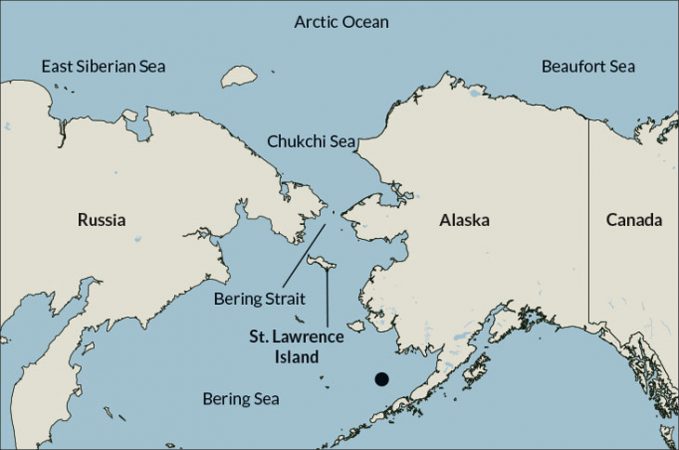
Were these findings a fluke? “We don’t yet have enough data,” says Jacqueline Grebmeier. She works at the University of Maryland’s Center for Environmental Science in Solomons. But Grebmeier, who has studied seafloor life in the Arctic for more than 30 years, has a gut feeling that the ice-free winter is not a one-off event: “I think it’s the beginning of change,” she says.
If last year’s events signal a new normal for the Bering Sea (and the very low sea ice cover as of March this year signals they might), then a cascade of changes are in store for its complex ecosystem — from the algae at the bottom of the food web to humans at the top.
Warming signs
There were early signs that conditions in the winter of 2017 to 2018 were going to be different. By November 2017, the sea ice was already late.
Phyllis Stabeno is a physical oceanographer with the National Oceanic and Atmospheric Administration (NOAA). She works at its Pacific Marine Environmental Laboratory in Seattle, Wash. Air temperatures above the waves were typical for November, she reported at the December meeting. But a sustained wind was blowing from the south. That wind prevented ice from drifting down from the Chukchi Sea as it normally would.
The wind died down by December and January. By this point, air temperatures were warmer than normal. The Chukchi Sea, instead of being mostly covered by thick ice, still had large swaths of open water. That meant less ice was available to migrate south through the Bering Strait.
Mooring M8, Peggy’s cousin, is about 800 kilometers (500 miles) northwest of Peggy. It has been reading water temps just above the seafloor since 2008. And that water was more than 3 degrees Celsius (5.4 degrees Fahrenheit) warmer than normal. In fact, M8 had never recorded so little winter ice here.
By February 2018, strong southerly winds picked up. The strange wind direction lasted through March. Scientists think those winds kept the Chukchi Sea warm. They pushed warmer waters north from the Bering Sea.
That warm water also stopped sea ice from forming. The ice that did form in the Chukchi and Bering seas was thin and easily pushed north by the winds.
By the summer of 2018, Peggy was recording the highest water temperatures yet. And near-seafloor water never dropped below freezing.
Feeding time
Sea ice is an anchoring part of the Bering ecosystem. That ice helps determine when and where food becomes available to creatures living in the water or on the seafloor.
As the migrating sea ice moves south, it melts. That meltwater is less salty and less dense than the surrounding water. As a result, the water forms layers. The fresher water full of nutrients stays on top.
The meltwater also helps give rise to springtime blooms of algae in the southern Bering Sea. Those blooms in turn feed copepods and other small floating creatures. And when these algae die and sink to the seafloor, they provide an important food source for animals living there.
But the absence of sea ice meant that the water didn’t form layers until later in the spring. So the algae bloomed later, too. Not every Bering Sea dweller can quickly adjust to those delays in the food web.
“The timing is important,” Grebmeier says. “It’s a question of how fast [the animals] can adapt.”
Owing to the winds and warmth, little sea ice managed to form within the Bering Sea. That meant no deep, cold pool near the seafloor.
A changing Arctic
The dramatic absence of sea ice last winter was startling. But waters in the Arctic have been on a decades-long warming trend. Since 1981, the southern Chukchi Sea has frozen over about half a day later each year. Stabeno and her colleagues shared the findings last November in Deep-Sea Research.
In the northern Bering Sea, M8’s data show stark changes over the last four years. From 1981 to 2014, the Bering froze over on average by the end of December. But since 2014, it hasn’t frozen over until January or February. In 2018, the Bering Sea didn’t freeze over at all.
This warming trend has had trickle-down effects on seafloor dwellers. Species such as bivalves that once carpeted the seafloor around St. Lawrence Island in the Bering Sea have shifted northward, Grebmeier says.
In 2010, Grebmeier helped establish the Distributed Biological Observatory. It is a worldwide program to monitor long-term ecosystem changes in the Arctic. Researchers visit designated “hot spots” year after year. These include the Bering and Chukchi seas. One such hot spot is just south of St. Lawrence Island, where the deep-cold pool normally forms.
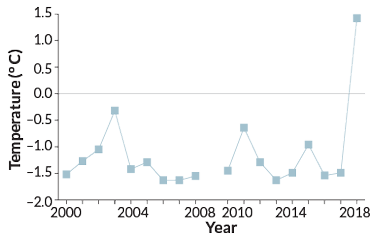
Seafloor bivalves here used to provide a nutritious, fatty meal for walruses and seals. And spectacled eiders (EYE-ders) — a kind of sea duck — dove for the mollusks. The birds had used the sea ice as a safe, stable launch pad.
But over time, those bivalve patches have given way to less-hearty marine worms, Grebmeier says. The food shift and the loss of sea ice is a one-two punch for the birds. Today, she says, they are at risk of extinction. “It takes less energy to sit on the ice and feed on underlying prey than to swim,” she says. “So the impact on these organisms is dramatic.”
Other creatures in the Arctic have taken a hit as well. Researchers have measured an increase in the small copepods that newly-hatched pollock eat. But fattier and more nourishing large copepods are in decline. That is bad news for young fish that need the larger copepods to survive through the winter.
These changes in prey have had cascading impacts on the food web. For instance, changes in the location and types of fish have spelled doom for thousands of seabirds. Last summer was the third year in a row to see a massive seabird die-off, notes Calvin Mordy. He is a biological oceanographer with NOAA’s Pacific Marine Environmental Laboratory in Seattle. Especially notable: The seabirds showed evidence of starvation, not disease, he reported at the December AGU meeting.
Feeling the heat
Past records suggest that the duo of wind and warmth that led to last winter’s record-low Bering Sea ice was unusual. The question, Stabeno says, is how typical these conditions will be in the future.
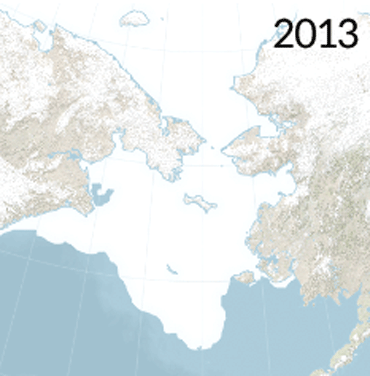
The Arctic is warming twice as fast as the rest of the Earth. It has an average temperature about 1.7 degrees C (3 degrees F) above the long-term average during 1981 to 2000. That’s according to the 2018 Arctic Report Card. It’s NOAA’s annual report on the state of the Arctic.
In fact, the five years since 2014 are the five warmest that scientists have ever measured, says Emily Osborne. She is the lead editor of the 2018 report card and a climate scientist. Osborne works for NOAA’s Arctic Research Program in Silver Spring, Md.
Last year was the second-warmest year on record, topped only by 2016, she says. One visible effect of the temperature rise is a sharp decline in summer sea-ice cover. The last 12 years are the 12 lowest on record.
Rising air and ocean temperatures aren’t the only signs of change in the Arctic Ocean. Runoff from local rivers is having an impact, too. The Arctic Ocean is “the most land-dominated ocean in the world,” says Karen Frey. She is a polar scientist at Clark University in Worcester, Mass. “It’s a dumping ground for everything” from river sediment to algae, she adds. “All roads lead to the Arctic.”
Arctic overload
In 2018, the volume of water discharged from the eight largest rivers emptying into the Arctic Ocean was about 20 percent higher than in the 1980s. The spike was due to a number of factors related to global warming. They included the decline of permafrost and increasing rainfall in the High Arctic.
All of that material pouring into the ocean delivered more nutrients. That, the warmer waters and more sunlight shining through the surface all led to larger algal blooms, Frey says. Some of those algae release poisons, but scientists don’t yet know how toxic they are. The algal blooms are similar to recent deadly red tides along Florida’s coasts. Some algal poisons kill fish and may cause brain damage in people.
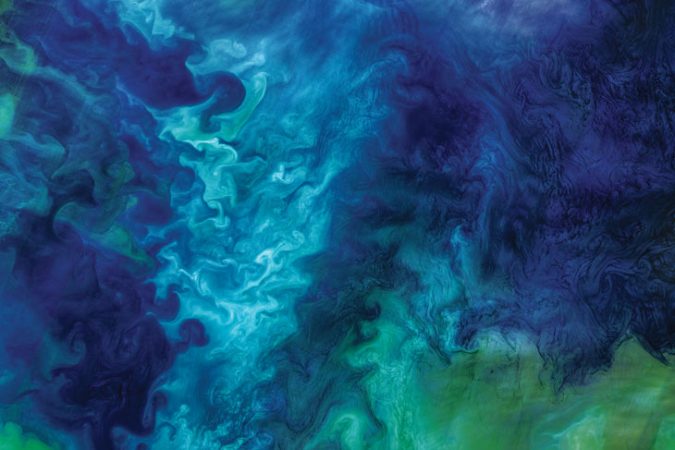
Cases of paralytic shellfish poisoning have increased seven-fold in Alaska over the past 40 years. The state now has one of the highest incidences of shellfish poisoning in the world. And the surge of harmful algal blooms may be partly to blame, says Frey.
The frequency of and number of sites affected by these harmful algae have both skyrocketed in recent years. That has prompted the first special section on harmful algal blooms in the 2018 Arctic Report Card.
The culprits may be algae that have “been present in many areas at low levels that wouldn’t be harmful. But the minute you start warming seawater … and removing sea ice, they adjust,” Frey says. “We are just starting to make measurements of harmful algal blooms and starting to understand how those species in the Arctic respond to light. It’s a very new question that has yet to be answered.”
A view of the future
Frey visited the Bering Sea last July as part of the Distributed Biological Observatory program. She measured how less and thinner sea ice together changed how much light reaches beneath the water’s surface. More light means more algal blooms. Even the thinner ice could have a big effect on how much light makes it through, she finds.
Thin ice is often covered in melt ponds. These areas “are basically skylights” for the waters below, she says. Melt ponds on the surface of the sea ice can boost how much light reaches the water, bringing it from about 10 percent to as much as 60 or even 70 percent. Frey reported her team’s findings at the December AGU meeting.
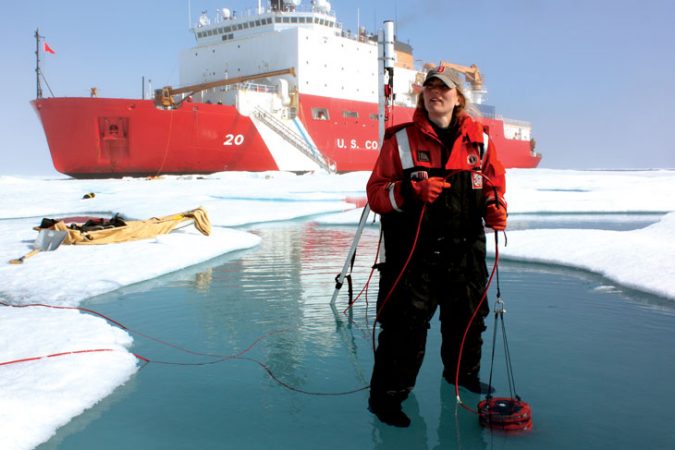
The increase in blooms was dramatic in 2018, the Arctic Report Card notes. Less sea ice and more melt ponds meant more light was reaching the Arctic’s waters earlier in the year. That prompted blooms in the northern Bering Sea (even as the south bloomed later.)
The northern waters bloomed as early as March. They normally see blooms in May. The amount of algal biomass in March was about 275 percent higher than the average March biomass for 2003 to 2017.
Scientists are still studying how big a role the harmful blooms may be in seabird dieoffs. Bloom-related poisons have been linked to other mass wildlife deaths in the last few years. Animals including walruses, seals and whales probably ate tainted fish and shellfish, just as people did, the Arctic Report Card notes.
“Historically we shouldn’t be seeing another year like [2018],” Stabeno said in December. In fact, “what we saw this year was predicted to happen in 2050,” she added. So last winter, she said, “gives us a view of the future.” And that low-ice future appears to be arriving faster than anyone had suspected.






